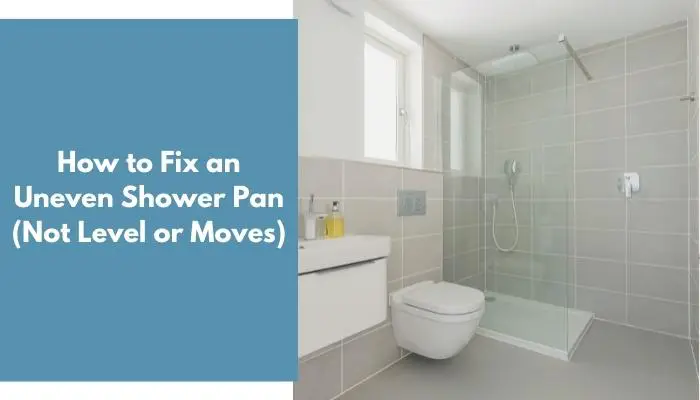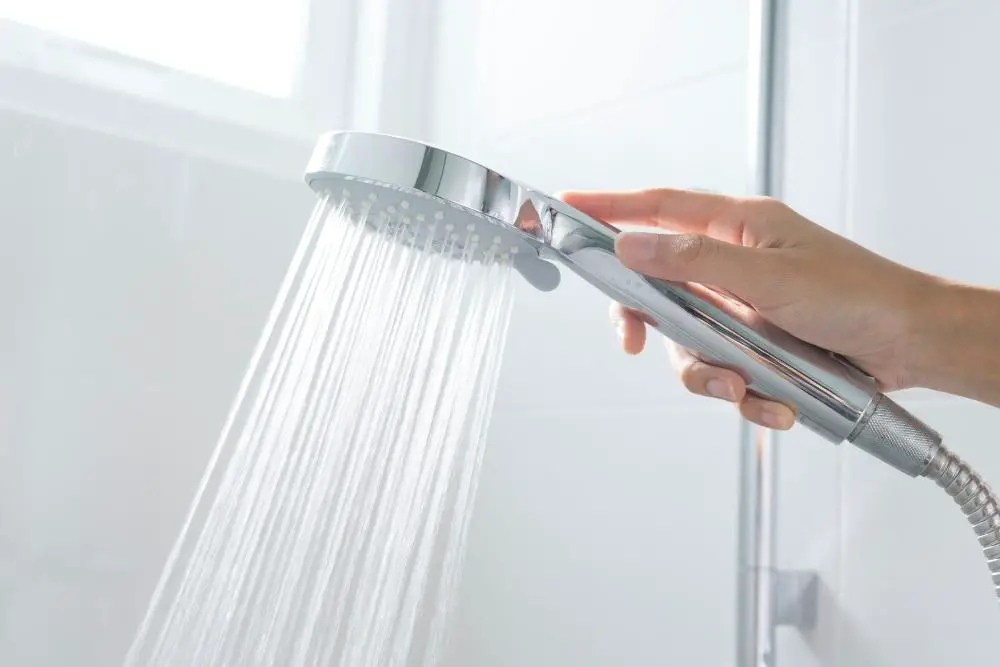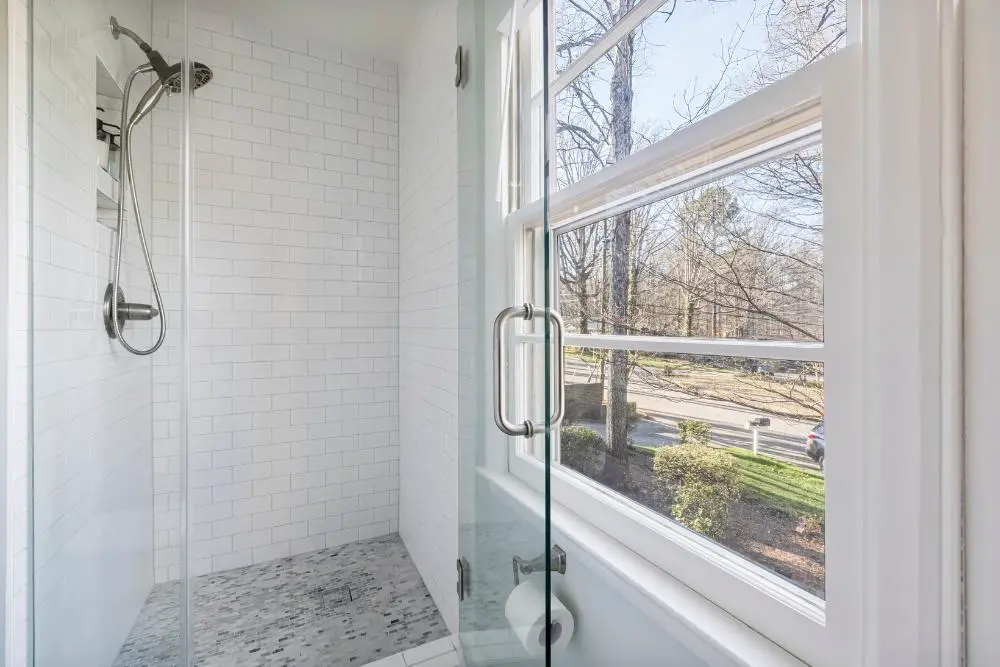Since most people don’t want to stand on a sloped surface while taking a bath, having an uneven shower pan can be very dangerous and frustrating. An uneven shower floor can create pools of water that won’t drain. This issue can also lead to dead spots on the floor.
Before you can start working on a floor level, you need to determine the cause of the issue. You can do this step depending on the location of the shower pan, its construction, and the moisture level.
You can use various options to level it, such as adding plastic shims, installing versatile fittings, and replacing the whole shower pan as the last resort.
Read on and learn how you can fix uneven shower pans.
Contents
Why Is Your Shower Pan Moving/Not Level?
Aside from fixing the issue, it’s also essential to identify the cause of the moving shower pan. Doing so will allow you to make minor repairs and stabilize them.
Normal Flex Amount
Most prefabricated shower pans are solid and will feel like they originate from solid concrete as a tiled base. However, if you are used to the feel of a tiled shower base, you will notice the difference.
It is important to note that you can expect some small amount of flex in the hollowness of the pans, but this is not a problem if the water leakage has not occurred.
Poorly Braced Shower Pan
All types of plumbing fixtures come in a wide range of quality standards. Regarding the design and construction of shower pans, some are made from a thinner floor or have fewer support ribs.
It can result in a base that’s prone to flexing. If you’re planning on installing a new shower pan, ensure it’s not overly thin or poorly backed. Any insubstantial pan that rests directly on the floor is likely to flex.
Excessive Usage
Although shower pans have weight limits, you should not use them over the recommended safe weight. Heavy use can cause the mortar bed to crack and collapse, leading to structural failure.
Not Cleaned Regularly
Over time, improper cleaning can lead to the deterioration of the shower pan’s structural quality. To avoid damaging the pan, use a drain cleaner and thoroughly clean it with water. However, be careful not to use chemicals that can cause the pan to crack, such as mineral spirits, paint thinner, acetone, and turpentine.
Incorrect Installation
There are two types of prefabricated shower pans: the ones installed on a bed of mortar and those flat on the floor.
If you do not install a mortar bed correctly, the shower pan will not be able to support itself properly. This issue will get worse over time. Even with better-quality pans, the pan will flex and move when someone showers.
The flat floor type, usually supported by a mortar bed, prefabricated shower pans do not require a concrete bed. They have support ribs designed to help the entire pan. However, these support ribs will not stick to the surface if the floor is uneven.
If the shower pan has support on one side with wood shims, it may not evenly support the ribs. This issue will eventually cause the wood to rot and collapse.
How to Fix an Uneven Shower Pan? (Not Level or Moves)
Depending on the cause of the shower pan’s unevenness, there are various ways you can fix this issue.
Install Plastic Shims
Without a mortar bed, a flexing shower pan resting on the floor may need to be supported more firmly along the length of its support ribs. It can be challenging to do once the pan is already in place. And it can also be tough to access the bottom from a room below the shower. To avoid wood rot, use plastic shims to support the pan.
Prices pulled from the Amazon Product Advertising API on:
Product prices and availability are accurate as of the date/time indicated and are subject to change. Any price and availability information displayed on [relevant Amazon Site(s), as applicable] at the time of purchase will apply to the purchase of this product.
Put Up Flexible Fittings
When installing a flexible drain fitting, most plumbers will install it below the shower pan. It allows them to react to the movement of the shower pan.
The flexible drain fitting accommodates the pan’s flex and bending when installed. It provides a shock absorber that it can use when the shower base begins to flex around the drain opening.
If the shower is constantly flexing and causing the connections to get damaged, you can install the flexible drain fitting below the shower head. You can cut small access opening in the ceiling to allow the fitting for installation.
Replace the Shower Pan
If the shower pan has started to flex, it’s usually the only option to fix it. Removing the base will allow the repairs to carry out. Aside from improving the pan, this can also involve laying a mortar bed over it to support the rest of the surface.
If you intend to replace your shower pan, you might consider installing a new one that is more resistant to flex. However, if you have a mortar-based shower pan, you must purchase a new one.
Prices pulled from the Amazon Product Advertising API on:
Product prices and availability are accurate as of the date/time indicated and are subject to change. Any price and availability information displayed on [relevant Amazon Site(s), as applicable] at the time of purchase will apply to the purchase of this product.
How to Install a Shower Pan in Your Bathroom?
When it comes to shower room remodeling, one of the most common tasks is the installation of a new shower pan. It can be relatively easy to master depending on your skill level.
Prepare the Space
Before working on the new shower, ensure the location is the right size. Clean out the space. The walls and the floor must be as clean as possible to allow you to level the pan.
Before working on the new shower, ensure the location is the right size. You can also measure the drain and line it up with the walls.
When the pan is in position, ensure it is sitting level. You can also use a pair of shims to help even out and mark the studs with a pen to make them easier to put back in. You can additionally test the pan by putting some cardboard inside and walking around it to see how stable it is.
Attach the Shower Pan
Before installing the shower drain fitting, ensure that a layer of plumber’s putty covers the flange’s bottom. After securing the fitting, make sure that it is tight.
In most cases, the retaining nuts on the tailpiece of the drain fitting threads onto the part of the drain fitting that you will be attaching to the pan. You should also install the necessary hardware, such as the washer and gaskets.
Put the Mortar Base and Anchor the Pan
Stir up a bag of mortar and spread it over where the shower pan will be sitting. The thick mortar will allow the fins on the bottom of the pan to stick to it, creating a wooden shower floor. To keep the cleanup easier, leave the edges of the bag a few inches away from the pan.
Prepare the pan by carefully setting it on the mortar and ensuring the drain line is in place. Some shower pans have brackets and screws attached to the wall studs.
If you want to attach the pan’s flanges to the wall studs using large screws, you can use them with roofing nails or other large heads. Before stepping into the pan, let it sit overnight.
Frequently Asked Questions
What if I Leave the Shower Pan Uneven?
If you have limited resources and don’t have the time to fix a problem, a simple solution is to purchase a telescopic squeegee.
It will allow you to clean the water from your shower without leaving any residue. It’s important to note that you should do this process regularly so that you don’t have bacterial or mold growth.
Can I Use Thinset to Level Shower Pan?
Using thin-set mortar to fill low areas is not a good idea since it can get stuck in the tile when installed. Manufacturers do not recommend using a thin set to flatten or level the floor or wall.
You can alternatively install flexible fittings or plastic shims instead of relying on a thin set that will not last long. It’s better to install a new shower pan if there is an excellent unevenness.
Conclusion
You can quickly level the shower pan by adding plastic shims, replacing the entire pan, or installing various other accessories. If you cannot remove the floor of your shower, try re-sloping it using this three-step process. This method should help you stand on level ground.
If you are still unsure how to fix this issue, contact a trusted plumber to help you!









